The Race to the Moon
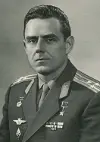 Several of the missions sent into space by the Soviet space program suffered from close calls. Tragedy struck in 1967, when Soyuz 1 crashed, with Vladimir Komarov aboard; his parachute did not open properly. Development of the N1 rocket was problematic as well, and scientists in the Soviet Union lagged behind their counterparts in the United States as the 1960s wound down. Several of the missions sent into space by the Soviet space program suffered from close calls. Tragedy struck in 1967, when Soyuz 1 crashed, with Vladimir Komarov aboard; his parachute did not open properly. Development of the N1 rocket was problematic as well, and scientists in the Soviet Union lagged behind their counterparts in the United States as the 1960s wound down.
The Soviet Union became the first nation to deliver living beings to circle the Moon and return them safely to Earth. They were tortoises, aboard Zond 5, which in September 1968 flew around the Moon but did not achieve orbit and returned to Earth, its animal payload intact. Apollo 7In the wake of Apollo 1, NASA scientists made the necessary changes, and production on Apollo missions continued. Two years later and skipping a few numbers, NASA launched its next manned mission. The Apollo 7 mission was a test of many improvements that NASA had made since the first Apollo mission: fire-retardant spacesuits and in-capsule materials, a nitrogen-oxygen mix in the interior atmosphere, and more resilient wiring throughout. 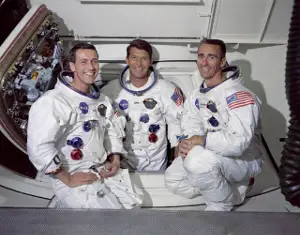
The crew of Apollo 7 featured Mercury and Gemini veteran Wally Schirra (right, center) as commander and two space rookies, Marine fighter pilot Walt Cunningham (right, right), and Air Force test pilot Donn Eisele (right, left), who had been slated for the Apollo 1 launch but had been replaced because of needing surgery. Again launching from Cape Kennedy's Launch Complex 34, the command service module (CSM), atop a Saturn I-B rocket, blasted into space on October 11. Completely dwarfing the achievements of Glenn and other Mercury astronauts, the Apollo 7 orbited Earth 163 times in 10 days, 20 hours. They tested the service propulsion system and did the first live TV broadcast from space. Apollo 8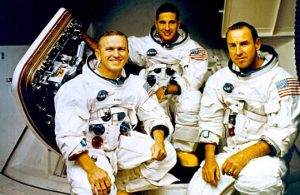 Following on that success was Apollo 8; launched on Dec. 21, 1968, it was the first manned mission to leave Earth's atmosphere and to orbit the Moon. The Command Service Module in which the crew of Commander Frank Borman (left, left), Command Module Pilot Jim Lovell (left, right), and Lunar Module Pilot William Anders (left, center) traveled was essentially the same as the one used on Apollo 7, with the exception of a new combined forward hatch, the primary function of which would be, on future missions, to allow astronauts to transfer to the Lunar Module. Among their primary tasks was to test the firing systems once they had achieved lunar orbit, simulating what an eventual lunar landing mission would do. They also tested the limits of communication and tracking systems. The Moon is more than 252,000 miles from Earth, and scientists did not know for sure whether they would be able to communicate or even track the spacecraft for that kind of distance. They were also to facilitate six live TV transmissions during the course of the mission.
Following on that success was Apollo 8; launched on Dec. 21, 1968, it was the first manned mission to leave Earth's atmosphere and to orbit the Moon. The Command Service Module in which the crew of Commander Frank Borman (left, left), Command Module Pilot Jim Lovell (left, right), and Lunar Module Pilot William Anders (left, center) traveled was essentially the same as the one used on Apollo 7, with the exception of a new combined forward hatch, the primary function of which would be, on future missions, to allow astronauts to transfer to the Lunar Module. Among their primary tasks was to test the firing systems once they had achieved lunar orbit, simulating what an eventual lunar landing mission would do. They also tested the limits of communication and tracking systems. The Moon is more than 252,000 miles from Earth, and scientists did not know for sure whether they would be able to communicate or even track the spacecraft for that kind of distance. They were also to facilitate six live TV transmissions during the course of the mission.
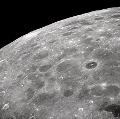
Apollo 8 arrived at the Moon in three days and set about taking photographs of the lunar surface, both on the near side and on the far side, again in preparation for a lunar landing. When it was time to return, Apollo 8 went one last time behind the Moon for a final burn, to power the return flight. Whenever the spacecraft went behind the far side of the Moon, their signal Next page > Putting It All Together > Page 1, 2, 3, 4, 5, 6, 7, 8 |
|
Social Studies for Kids
copyright 2002–2025
David White



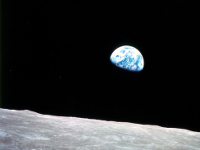 Along the way, they deviated from mission specifications slightly to snap one of the most photographs in human history, Earthrise. Anders was behind the camera, and his iconic shot of the parent planet was eclipsed only by what the crew did next. Because the crew were orbiting the Moon on Christmas Eve, they were inspired to use one of their TV transmissions to read from the Biblical book of Genesis the story of Creation. All three astronauts took turns reading from the Bible, their words traveling through space and to listeners back on Earth.
Along the way, they deviated from mission specifications slightly to snap one of the most photographs in human history, Earthrise. Anders was behind the camera, and his iconic shot of the parent planet was eclipsed only by what the crew did next. Because the crew were orbiting the Moon on Christmas Eve, they were inspired to use one of their TV transmissions to read from the Biblical book of Genesis the story of Creation. All three astronauts took turns reading from the Bible, their words traveling through space and to listeners back on Earth.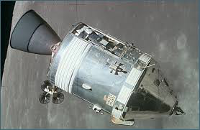 was lost and everyone on Earth held their breath. One of the first things that Lovell said to Mission Control when they had re-established contact was, "Please be informed, there is a Santa Claus." (This was not the first time that an astronaut had mentioned the iconic Christmas figure. Wally Schirra, the only astronaut to fly on Apollo, Gemini, and Mercury missions, made a mention of the
was lost and everyone on Earth held their breath. One of the first things that Lovell said to Mission Control when they had re-established contact was, "Please be informed, there is a Santa Claus." (This was not the first time that an astronaut had mentioned the iconic Christmas figure. Wally Schirra, the only astronaut to fly on Apollo, Gemini, and Mercury missions, made a mention of the 
